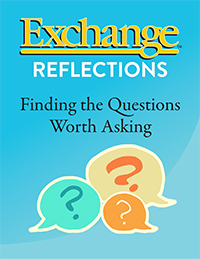ExchangeEveryDay Past Issues
 << Previous Issue
| View Past Issues | | Next Issue >>
<< Previous Issue
| View Past Issues | | Next Issue >> -Jane Austen, Sense and Sensibility
An all-new three-article Exchange Reflections, “Introverts? Extroverts? Supporting All Children,” invites educators to explore introversion and extroversion in our care and learning communities. According to Natasha Daniels, “introverts tend to observe a situation before they jump in. They build up confidence. The more they understand the environment and the people around them, the more relaxed they become.” She admonishes the readers of her article to “teach introverted kids how to have a voice, but don’t do it by taking their voice away.”
Meanwhile, Mosier and Chandler Nunamaker suggest, “The extrovert tends to seek interaction with others, whether direct or indirect. Therefore, an adult need
only be responsive to a young extrovert who is seeking interaction with the adult. When a young child wants social interaction, the adult role is to share in the activity that the child is engaged in playing. Simply put, follow the child’s lead. She or he will guide the degree of your attention that is wanted.”
Liane Nakano invites us to take an open-minded approach to these insights and apply them to classroom practice: “As educators, the challenge has been put upon us: to create a classroom culture of understanding and acceptance of all and move beyond labels and stereotypes that limit and/or define children and their behaviors. By weaving elements of The Image of the Child and using family culture as a lens into our pedagogy, we are able to have a better understanding of each child and family in our classrooms and thus support and honor them just as they are.”
We can further reflect on how our own tendencies toward introversion and extroversion impact how we respond to children with similar or opposite tendencies. This latest Exchange Reflections provides a framework to explore this through a guided discussion related to these three articles.
 |
ExchangeEveryDay
Delivered five days a week containing news, success stories, solutions, trend reports, and much more.
What is ExchangeEveryDay?
ExchangeEveryDay is the official electronic newsletter for Exchange Press. It is delivered five days a week containing news stories, success stories, solutions, trend reports, and much more.


Post a Comment